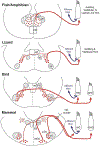The continued importance of comparative auditory research to modern scientific discovery
- PMID: 37084504
- PMCID: PMC10321136
- DOI: 10.1016/j.heares.2023.108766
The continued importance of comparative auditory research to modern scientific discovery
Abstract
A rich history of comparative research in the auditory field has afforded a synthetic view of sound information processing by ears and brains. Some organisms have proven to be powerful models for human hearing due to fundamental similarities (e.g., well-matched hearing ranges), while others feature intriguing differences (e.g., atympanic ears) that invite further study. Work across diverse "non-traditional" organisms, from small mammals to avians to amphibians and beyond, continues to propel auditory science forward, netting a variety of biomedical and technological advances along the way. In this brief review, limited primarily to tetrapod vertebrates, we discuss the continued importance of comparative studies in hearing research from the periphery to central nervous system with a focus on outstanding questions such as mechanisms for sound capture, peripheral and central processing of directional/spatial information, and non-canonical auditory processing, including efferent and hormonal effects.
Keywords: Auditory system; Bone conduction; Comparative biology; Directional hearing; Ears; Hearing.
Copyright © 2023 The Author(s). Published by Elsevier B.V. All rights reserved.
Conflict of interest statement
Declaration of Competing Interest The authors declare no competing interests
Figures



References
-
- Alhajeri BH, Fourcade Y, Upham NS, and Alhaddad H, 2020. A global test of Allen’s rule in rodents. Glob Ecol Biogeogr 29(12): 2248–2260.
-
- Allen JA, 1877. The influence of physical conditions in the genesis of species. Radical Review 1: 108–140.
Publication types
MeSH terms
Grants and funding
LinkOut - more resources
Full Text Sources

